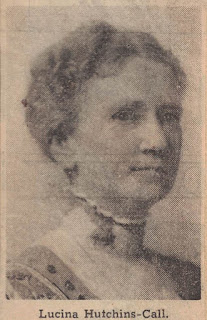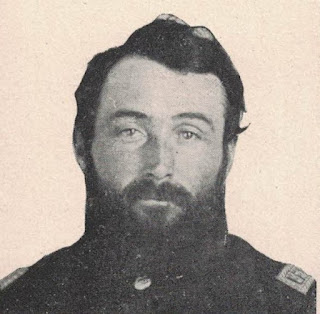Merrill Call is a grandson of Asa
Call. He is buried along with four
generations of Call family members in the tomb located in Riverview
Cemetery. Today I want to share the
story of the heinous crime that took his life at the age of 26.
FROM ALGONA TO SIOUX CITY
Born in Algona May 8, 1878, Merrill spent
much of his youth here until his parents, Asa Frank Call and Lucina Hutchins
Call, moved to Sioux City when he was 10 years old. He never lost his love for Algona and visited
often – especially his mother’s parents, Mr. and Mrs. D. H. Hutchins. He was an active cyclist—in fact when he was
16, he rode a bicycle here from Sioux City, making the trip in about 16
hours. It is hard for me to imagine the
condition of the roads that he had to travel on—it certainly would not have
been an easy trip. Earlier that same
year, he placed third in the five-mile bicycle race at the Kossuth County Fair
and won a fine sweater. Don’t you think that
given his love of cycling, he would have been an active participant in RAGBRAI if
he was alive today?
 |
| Merrill Call |
He completed high school in Sioux City
and later studied engineering at Purdue University. At the age of 20 he became the superintendent
of the Sioux City street car lines.
In 1903 Merrill married Lucy Tolerton
of Toledo, Ohio, and the two later had a daughter, Mary. After their marriage, he agreed to take a job
in the Tolerton family business. Lucy’s
father, in company with a number of Toledo associates, owned considerable
mining property located in Yaqui Indian country in the state of Sonora,
Mexico.
TOLERTON MEXICAN INVESTMENTS
Among the holdings of the group in the
Yaqui country was a smelter at Toledo camp, 35 miles from the nearest railroad
station. Merrill had recently been made a
manager at a salary of $10,000 per year-more than the pay of a United States
Senator.
A trip was organized in January of 1905
to inspect some nearby mining properties for the Yaqui Mining and Smelting Company,
of which his father-in-law was a stockholder.
There were eight members in the party, which included four other
employees, two Mexican drivers and Charles Tolerton, his wife’s cousin, who
came along as a pleasure trip. It was on
this trip that Merrill met his fate.
Realizing the unsettled and restless
condition of the Yaquis, before setting out on the expedition, they had put in
a request for a guard. The Mexican
authorities declared an escort to be unnecessary on account of the number in the
party and the fact that the Indians were not particularly hostile to Americans. Determined to reach the mines at any cost
they set out without the guard, heavily armed with six shooters. Merrill
himself carried a shotgun as did most of the rest of the party. Charles also carried a rifle and a dagger.
They had completed the inspection of
properties at camp Toledo and were returning in the late afternoon to La
Colorado, a distance of about 75 miles, traveling in two four-horse
stages. Call was traveling in the second
stage with Charles and two others.
They proceeded along a broken road,
each side of which was thickly grown up with mesquite grass. The road itself was much traveled and not
considered very dangerous. Great
quantities of silver bullion were hauled over the road every day to the
railroad for shipment. Unaware of any
lurking danger, they proceeded along the desert road. The horses were trotting slowly, the Mexican
drivers sitting on top. A low hill arose
from one side of the road, which passed around the foot of the hill in a
winding course, and was lost in the distance.
Inside the stages the men were chatting pleasantly when suddenly,
without any warning, there was a volley at close range, and bullets whizzed in
all directions.
Everybody jumped out of the stages in
an instant. Herbert Miller, a passenger
in the first stage who was familiar with the country and its dangers, yelled
“For God’s sake, boys, run! It’s the
only way you can be saved!”
A FIGHT FOR THEIR LIVES
At a ranch house where they had stopped
not long before, the members of the party had been joshing each other about
being heavily armed, and it had been generally agreed that it would be better
to make a good run than to stand and be shot in case of an attack by the
Yaquis. But at the critical moment most refused
to run. However, when Miller gave the
warning, Charles Tolerton threw down his rifle and ran. Charles, Miller and one of the Mexican
drivers took to their heels and they are the only three who made it out alive.
The Indians must have numbered 75 from
the way they fired, for bullets came thick and fast. The first volley killed the Mexican driver of
the second stage and he reeled off the rig, his body riddled with bullets. Another volley snuffed out the lives of two
party members, who fell in their tracks after jumping from the first stage. A passenger in Merrill’s stage, Walter
Steubinger, was the next victim. He was
killed after leaving the rig. One of the
four horses from the first stage was killed by a bullet from one of the rifles
and the Mexican driver leaped to the ground and made it up the hill.
At the first volley, Merrill had jumped
to the ground and took refuge behind a stump, where he used his shotgun in the
hope of affording escape to the other members of the party. He took one shot to the abdomen but was able
to struggle up to his knees and continued pouring shot into the Indians, until
a bullet in the neck ended his life.
The Indians frightened the horses and
they started up the road at a breakneck speed.
As it rounded the turn of the hill, Charles was barely able to clutch
the end gate of the wagon, and, swinging himself into the vehicle, drove with
all speed toward town with five Indians in hot pursuit, yelling and shooting as
they rode.
After traveling several miles, one of
the horses fell dead. Charles quickly leaped
from the wagon and, cutting the lead team loose from the pole of the stage, threw
an overcoat on one of the horses, and, leaping upon him, continued his mad
ride. The Indians stopped their pursuit
when they reached the stage. Tolerton
rode on to Cobachi, about ten miles from where the attack occurred. The village was made up of Mexican ranchers
who did not speak English. It took some
time to find anyone who could understand English.
Miller, in the meantime, had made good
his escape and, closely followed by the Mexican driver, hastened to a town in
another direction, running the entire distance.
He explained the attack to the inhabitants of the town and a rescuing
party was quickly made up and hurried to the scene of the attack.
When the party arrived the Indians had
escaped. The Indians had stripped all of
the bodies which had been beaten with rocks and clubs. The bodies were removed to the home of a
rancher. The next day they were
delivered under a heavy guard into the hands of an undertaker to prepare for
shipment home. It was only after all
arrangements had been made that Miller finally had his own injury treated. He had been shot in the hip and endured his
pain and suffering until he was satisfied that the bodies would be safely returned.
BODY BROUGHT HOME
 |
| Merrill's mother |
Merrill Call’s body was returned to
Sioux City for funeral services. From
there it traveled by special funeral train to Algona accompanied by his wife, his
parents and other family and friends.
The funeral cortege arrived in Algona very early in the morning and the
party remained in the sleeper until about 7 am when friends in Algona sent
carriages for them and brought them to the Durdall Hotel for breakfast. His casket was removed from the train to the
Call family vault here in Riverview cemetery prior to the gathering of
friends. The interior of the tomb was
banked with carnations and roses. A
short service was conducted by Rev. Holmes.
There was a large attendance of sympathizing friends of the family at
the interment, despite the zero weather prevailing.
INVESTIGATION OF ATTACK
Although it was originally thought that
the attackers were Yaqui Indians, following the massacre Herbert Miller found
inconsistencies and continued to investigate the matter. Yaqui Indians were known to purchase their
ammunition in the United States. Empty
shells picked up on the ground at the scene of the tragedy were of the Mauser
type, which convinced him that they were purchased or obtained in Mexico as the
Mauser was very little used in the United States. He became confident that it was Mexicans -- not
Yaqui Indians -- who were responsible for the murders.
During a follow up trip to Mexico, the
Governor of Sonora demanded a meeting with Miller at which he accused him of
plotting against the Mexican government.
In fact, the Governor went on to accuse Miller himself of committing the
murders claiming that his mines were worthless and that he did not want the
rest of his party to give out a bad report so Miller had the whole party
killed. Further the Governor demanded
that Miller provide him with a statement relieving the Mexican government from
all responsibility. Of course, Miller
refused to do so.
Miller joined forces with Merrill’s
uncle, Joe Harry Call, of Los Angeles and Ex-Senator John M. Thurston of
Nebraska to pursue an indemnity claim for $450,000 against the Mexican
government. He was convinced that it was
the duty of the United States to demand instant protection for Americans from
the Mexican government. It threatened to
turn into an international incident.
THOSE LEFT BEHIND
 |
| Merrill's father |
Merrill’s death was a particular blow
to his parents as he was their last surviving child -- his brother Joe
succumbed to typhoid several years before, leaving only Merrill to carry on the
family name. Many dreams of his parents
died with him. In fact, their grief was
such a strain on their relationship that they later divorced.
Following his death, his widow and
daughter first moved to Sioux City to live with Asa Frank Call, Meriill’s
father, and then moved to Sonoma County, California, where his father owned a
citrus farm. It was near that home where
his father was hit by a train and killed a few years after Merrill’s
death. Although he wished his ashes to
be scattered “as though he had never existed,” they are interred here in the
Call tomb. Merrill’s precious little daughter
Mary was Asa Frank’s sole heir.
In 1914, Lucy married Richard Kirkley. She went on to have a second daughter and
lived to the age of 97. She remained in
California for the rest of her life and is buried at Riverside, a half a
continent away.
Such a sad ending to very a promising
life.
Until next time,
Jean
If you enjoyed this
post, please don’t forget to “like” and SHARE to Facebook. Not a Facebook
user? Sign up with your email address in the box on the right to have
each post sent directly to you.
Be sure to visit the
KCHB Facebook page for more interesting info about the history of Kossuth
County, Iowa.
Reminder: The posts on Kossuth County
History Buff are ©2015-17 by Jean Kramer. Please use the FB “share”
feature instead of cutting/pasting.

